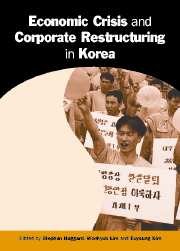Book contents
- Frontmatter
- Contents
- List of Figures
- List of Tables
- Preface and Acknowledgements
- Contributors
- A Note on Usage
- Abbreviations
- 1 Introduction: The Political Economy of Corporate Restructuring
- Part I The Politics and Economics of the Chaebol Problem
- Part II The Political Economy of Crisis Management
- Part III Reform and Restructuring
- 9 The Corporate Bankruptcy System and the Economic Crisis
- 10 Foreign Direct Investment and Corporate Restructuring after the Crisis
- 11 Competition Law and Policy
- 12 Reform of Corporate Governance
- 13 Conclusion: Whither the Chaebol?
- Index
9 - The Corporate Bankruptcy System and the Economic Crisis
Published online by Cambridge University Press: 05 July 2014
- Frontmatter
- Contents
- List of Figures
- List of Tables
- Preface and Acknowledgements
- Contributors
- A Note on Usage
- Abbreviations
- 1 Introduction: The Political Economy of Corporate Restructuring
- Part I The Politics and Economics of the Chaebol Problem
- Part II The Political Economy of Crisis Management
- Part III Reform and Restructuring
- 9 The Corporate Bankruptcy System and the Economic Crisis
- 10 Foreign Direct Investment and Corporate Restructuring after the Crisis
- 11 Competition Law and Policy
- 12 Reform of Corporate Governance
- 13 Conclusion: Whither the Chaebol?
- Index
Summary
After the economic crisis broke in 1997, Korea undertook a reform of the corporate bankruptcy system in 1998–99. These reforms were not sweeping but piecemeal, maintaining the existing legal framework intact. What, if anything, did the reforms achieve? Two years after the reforms, debate on reforming the corporate bankruptcy system continued; by the end of 2001, another round of bankruptcy reform was still pending. What weaknesses did the bankruptcy laws and procedures have to prompt another round of reform?
In discussing these issues, we focus on whether rehabilitation procedures targeted the right firms. Rehabilitation programs should target firms that go bankrupt because of temporary bad luck, but have a high potential for recovery. If firms do not meet this criterion, then rehabilitation programs are doomed from the start. Another related issue is the timing of filing for bankruptcy procedures. If ailing firms file for bankruptcy procedures too late, prospects for recovery are damaged.
In order to assess the effectiveness of bankruptcy procedures, we look at firm-level data on productivity, a major indicator of corporate performance (see Chapter 5). The information on corporate bankruptcy was gathered from such sources as the courts, the Financial Supervisory Service and the Bank of Korea. We analyze both the cross-sectional distribution of corporate bankruptcy and the time series of ailing firms’ productivity before and after bankruptcy, using data on externally audited firms. We also compare the productivity distribution of ailing firms for different rehabilitation procedures with an eye on the changes in laws and procedures introduced in 1998 and 1999.
- Type
- Chapter
- Information
- Economic Crisis and Corporate Restructuring in KoreaReforming the Chaebol, pp. 207 - 232Publisher: Cambridge University PressPrint publication year: 2003
- 1
- Cited by



